Windermere Real Estate is proud to partner with Gardner Economics on this analysis of the Western Washington real estate market. This report is designed to offer insight into the realities of the housing market. Numbers alone do not always give an accurate picture of local economic conditions; therefore our goal is to provide an explanation of what the statistics mean and how they impact the Western Washington housing economy. We hope that this information may assist you with making an informed real estate decision. For further information about the real estate market in your area, please contact your Windermere agent.
REGIONAL ECONOMICS
There’s an old saying in Western Washington that you have to wait until the 5th of July for summer to start and that, after a prolonged period of tedium, light starts to shine. In reviewing the latest data on the economy and real estate markets, I believe the same can be said about them.
In aggregate, the job market in our region now appears to have come out of the darkness and is showing solid gains across a majority of the counties surveyed within this report. Between June of 2011 and June of 2012, the area added 58,070 jobs—a 2.7% growth rate, which exceeds both Washington State as a whole, as well as the United States. In our region, ten counties expanded their employment base with just six showing modest contraction. If we compare the data to the first quarter of this year, just one county, Grays Harbor, did not add jobs.
Year-over-year, Snohomish County continues to grow at the greatest rate—a function of the buoyant aerospace industry. This was followed by Whatcom (3.9%) and King (3.3%) Counties. Job losses were relatively modest with Grays Harbor (-4.4%), Kittitas (-3.3%), Jefferson (-2.9%), and Clallam (-1.5%) Counties suffering the largest job losses.
Looking at unemployment, all areas saw the rate improve when compared to a year ago.
The latest data is impressive indeed and has exceeded my expectations. As a result, I am going to give the current employment situation a solid “B” grade, up another notch from the last quarter.
The region has seen notable gains for several quarters now, and what is most impressive is that it has come despite continued reduction in government employment. The private sector in our region has taken the bull by the horns and continued to grow despite the uncertain macroeconomic and political environment.
Growth in our region has become the envy of the West Coast and I hope that this can be sustained.

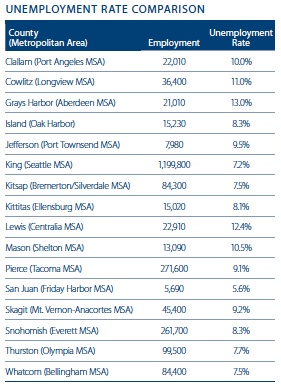
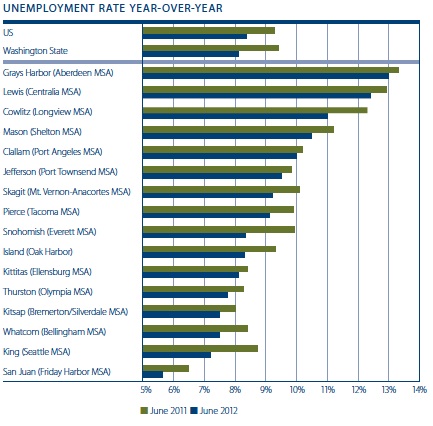
REGIONAL REAL ESTATE
The Western Washington market registered 21,651 transactions of resale housing units in the second quarter of this year—another impressive increase of 14.4% from the same period a year ago.
The spring market may have come late, but it certainly arrived with a vengeance with all but two counties exhibiting improving sales velocities over the same period in 2011. The counties where there were sales declines are somewhat of an anomaly, as both are small areas and the absolute losses were equally small.
That said, the late spring market was clearly evident with all counties surveyed improving in home sales when compared to the previous quarter.
From a transactional standpoint, the data shows solid improvement, but there is a caveat: units available for purchase declined across all the counties surveyed and this is a concern. Although most markets saw a modest uptick in listings during the quarter, the number of units for sale is down substantially from a year ago, as well as the long-term trend.
Much of this can be attributed to the slowdown in banks listing foreclosed homes for sale. Another factor is that homeowners who are marginally underwater are waiting to list their homes until prices rise sufficiently to enable them to sell and not owe money to their mortgage holders.
Choice in many markets has become limited which, if it does not improve, will likely lead to a slowdown in transactions in the second half of 2012.
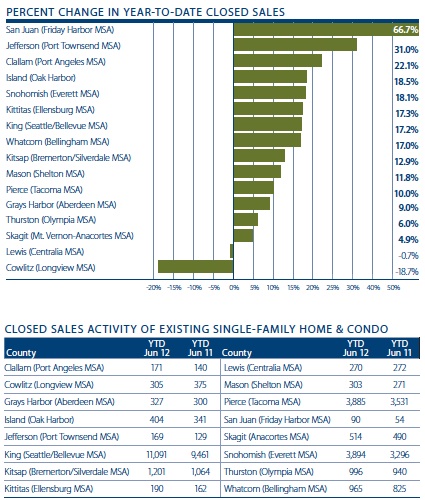
As is shown in the chart to the right, ten counties saw the average sales prices at levels above those of a year ago, five counties are at lower price levels, and one was static. Prices of home sales in the counties analyzed have turned around with aggregated prices 1.6% higher than seen in June of 2011. The disclaimer remains that this figure excludes the highly volatile San Juan County. If we include it, prices paid for homes dropped by a modest 1.7% year-over-year.
Of the counties that saw appreciation, the most pronounced gains were seen in Kitsap (+12.1%) and Lewis (+10.5%), followed by Snohomish and Island which both saw 7.9% growth. The greatest declines were seen in the previously mentioned San Juan County (-23.8%), followed by Clallam (-20.1%) and Cowlitz (-12.9%) Counties.
Previously in this report, I mentioned my concern with the low level of inventory in almost all of the counties surveyed and that it will likely have a negative effect on overall sales as we move forward. This not only has an effect on the number of sales in an area, but also home prices.
If we do see an increase in distressed units coming to market—and I have no doubt that we will—this is likely to cause the growth in prices to slow down, or even decline. This is due to the fact that distressed homes usually sell for less than market which can drag the overall average down, especially if we do not see a large increase in non-distressed listings to offset it.
I am actually going to hold the grade for home values at a “C” this quarter. It would be easy to get caught up in the long-awaited improvement in prices that we saw in the quarter, but due to the factors previously mentioned, I am adopting a “wait-and-see” attitude.
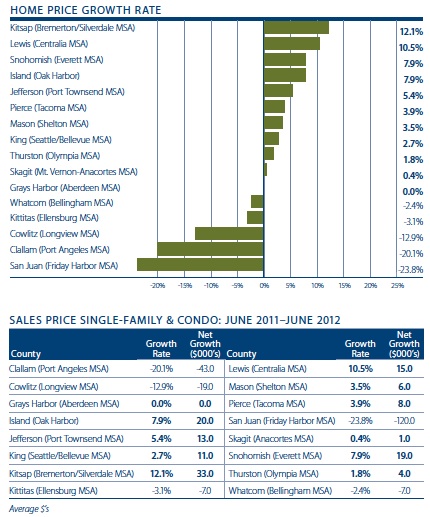
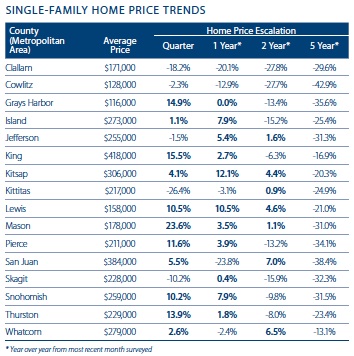
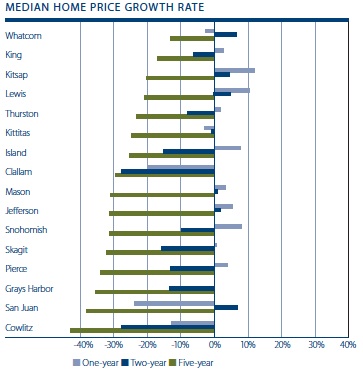
CONCLUSIONS
Summer has appeared in Western Washington and this has, so far, been reflected in our economy, as well as our housing market.
Businesses have been adding staff at a fair clip and, to a degree, this has influenced people’s decision making when it comes to buying a home. The two are, indeed, intertwined.
Even with this positive data, I am still suggesting that we be a little cautious regarding the housing market. Not because I believe that we are going to see any sort of rapid decline in values, rather that the long-awaited improvement that is shown here may still have some hurdles ahead.
The wait for summer has been worth it—as has the very long wait for recovery/stability in our regional economy real estate markets. The glass is definitely half full right now, but it remains too early to call for a certified recovery in home prices. Enjoy the weather while it is here!
ABOUT MATTHEW GARDNER
Mr. Gardner is a land use economist and principal with Gardner Economics and is considered by many to be one of the foremost real estate analysts in the Pacific Northwest.
In addition to managing his consulting practice, Mr. Gardner is a member of the Pacific Real Estate Institute; chairs the Board of Trustees for the Washington State Center for Real Estate Research; the Urban Land Institutes Technical Assistance Panel; and represents the Master Builders Association as an in-house economist.
He has appeared on CNN, NBC and NPR news services to discuss real estate issues, and is regularly cited in the Wall Street Journal and all local media.
 Facebook
Facebook
 X
X
 Pinterest
Pinterest
 Copy Link
Copy Link



